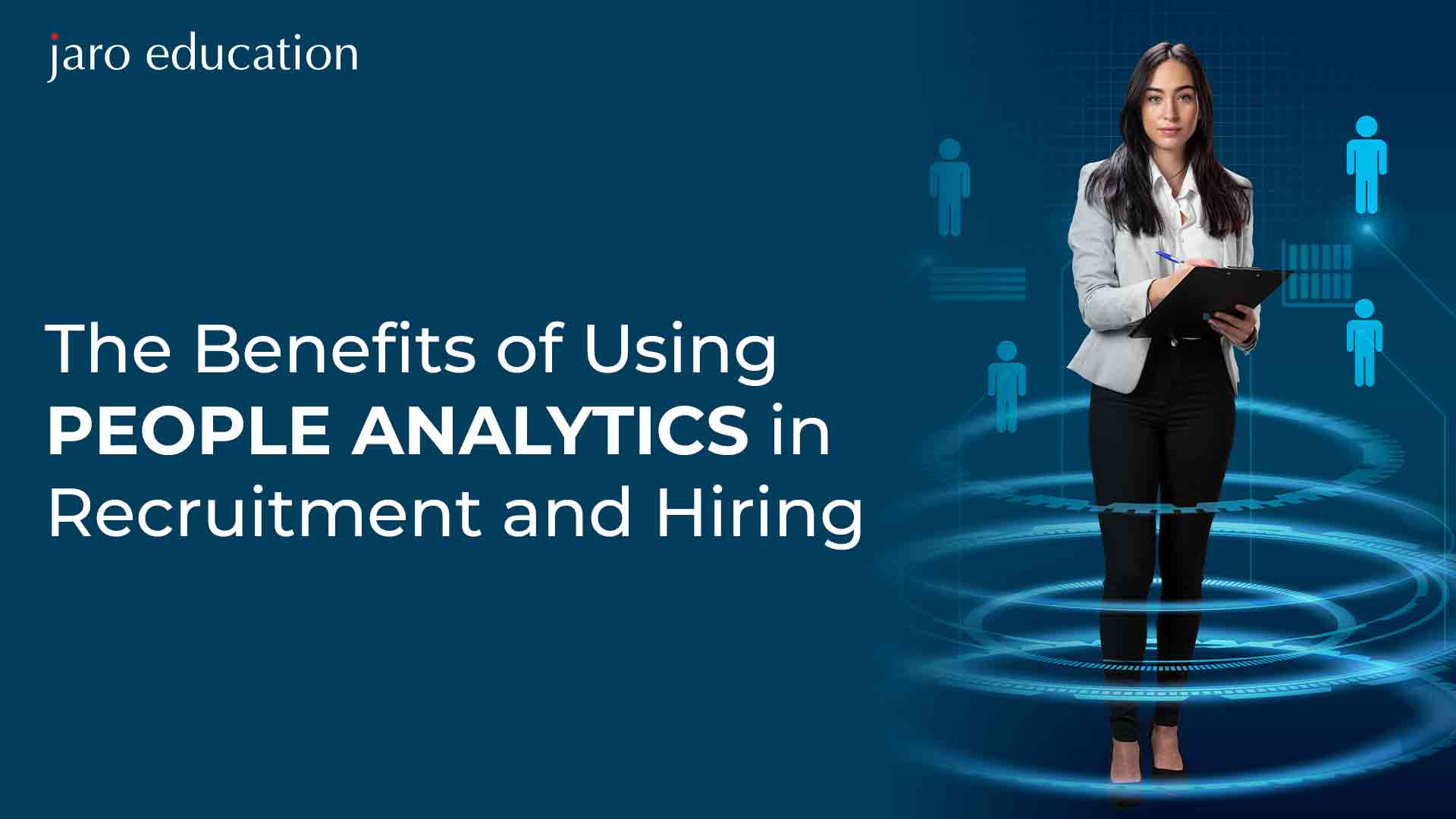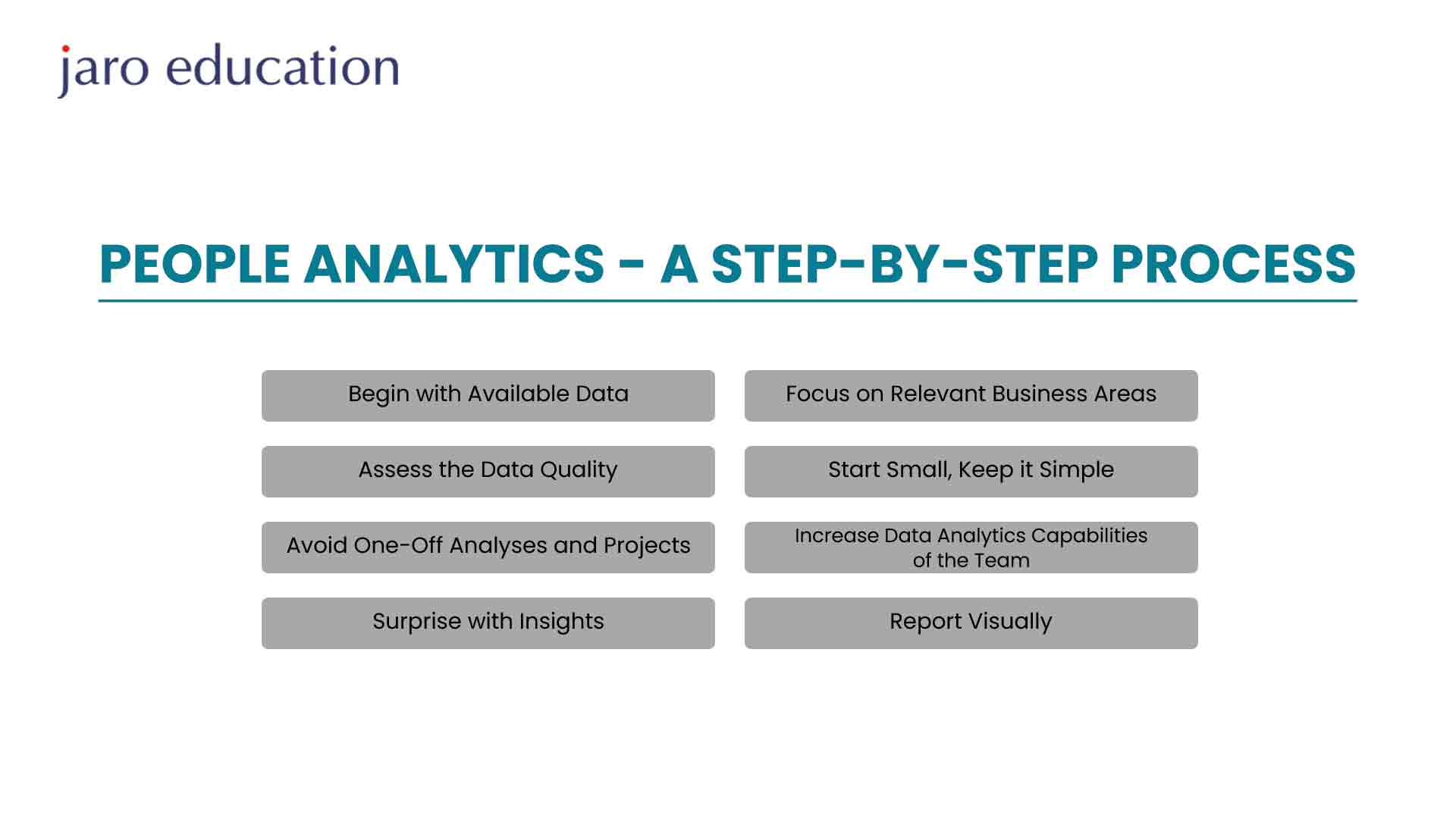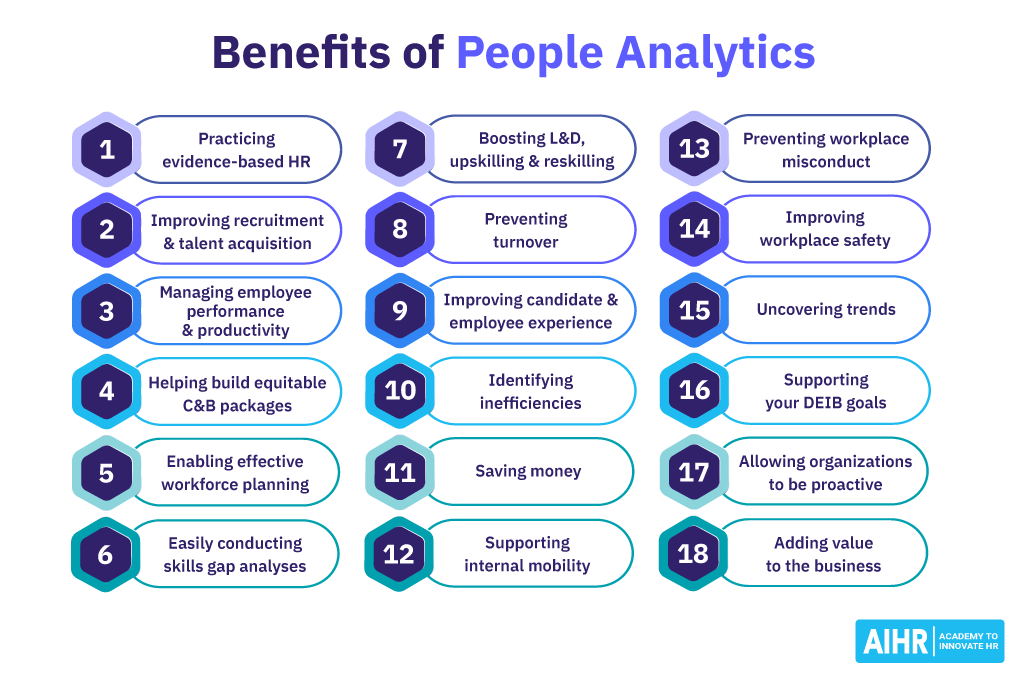
- jaro education
- 25, April 2024
- 3:57 pm
People analytics, also known as talent or HR analytics, is revolutionizing how organizations approach human resource management. It involves a deeply data-driven approach to understanding processes, challenges, and opportunities within the workforce. McKinsey & Company reported that by leveraging advanced analytics techniques, such as data science and machine learning, can yield significant benefits, including an 80% boost in recruiting efficiency, a 25% increase in business productivity, and a 50% reduction in attrition rates.
Despite its transformative potential, many organizations still rely on instinct rather than data. However, the shift towards data-driven insights is gaining momentum as businesses realize the benefits of rigor, reduced bias, and improved performance that people analytics offers.
In this blog, we explore how people analytics is reshaping HR decision-making, empowering organizations to achieve sustainable success through strategic and data-backed talent management.
Table of Contents
What is People Analytics?
People analytics, also called Human Resource analytics or talent analytics, is all about using data analysis to understand how candidates and employees impact a company’s goals. It helps HR teams figure out if their strategies are working well or if they need to make changes. The main aim is to make smarter decisions based on data.
This approach looks at different parts of the workplace, like the people, the challenges they face, how things work, the rules in place, and how the company can grow. Using math, stats, and special tools, HR teams analyze data about candidates and employees to spot trends and predict what might happen during hiring, keeping staff, and managing them.
With people analytics, HR departments can team up with data experts to learn more about things like finding the right people for job openings, keeping employees happy so they don’t leave, figuring out who’s doing well at work, boosting overall productivity, and finding how well programs for training or development are working.

Process Involved in People Analytics
The process of implementing people analytics involves several key steps to ensure its effectiveness and compliance with legal policies:
Step 1: Develop a clear and concise plan that aligns with business objectives. This plan should outline the process of data analysis and interpretation in a way that is understandable and easily updatable. The metrics collected should directly contribute to achieving business goals.
Step 2: Select an appropriate people analytics tool that provides features such as data mining, transformation, and visualization. These tools are essential for processing and analyzing the collected data effectively.
Step 3: Gather relevant data that directly impacts business goals. For instance, if the objective is to enhance employee competency, data on training expenses and effectiveness should be collected. Focusing on collecting the right data enables organizations to optimize resources by analyzing only essential areas.
Step 4: Ensure compliance with legal regulations regarding data privacy. It is crucial to maintain employees’ privacy rights throughout the data collection process. Internal legal teams should review and validate data collection procedures, and metrics should be measured with transparency in mind.
If you want to learn the HR analytics process in detail, you should explore XLRI Jamshedpur’s Executive Development Program in HR Analytics. This course is designed to empower professionals with the skills to leverage analytics for a better grasp of data and people management, leading to effective solutions for real-life challenges. Through dissecting intricate datasets, participants will become adept at using analytics to uncover valuable insights for improved people management.
Key HR Metrics for Evaluation
Monitoring HR metrics is essential for assessing the efficiency of HR strategies and understanding how talent management practices influence business outcomes and financial performance. Several important HR metrics include:
- Absence Rate: This metric tracks the frequency of employee absences, providing insights into workforce attendance and potential productivity challenges. It can be measured on an individual or managerial level.
- Average Cost per Hire: This metric calculates the total expenses associated with hiring and onboarding a new employee, encompassing recruitment costs, training expenses, and other related expenditures.
- Benefits Participation Rate: This metric gauges the level of employee engagement with offered benefits packages, indicating the effectiveness of benefits programs in attracting and retaining talent.
- Cost of HR Personnel per Employee: This metric evaluates the allocation of resources towards HR functions relative to the size of the workforce, reflecting the efficiency of HR operations.
- Diversity Metrics: These metrics assess the diversity within the workforce, including factors such as gender, ethnicity, and age, highlighting the organization’s commitment to inclusivity and diversity.
- Compensation Analysis: This metric examines the distribution of salaries and benefits across different roles and departments, ensuring fair and competitive compensation practices.
- Employee Engagement: Measuring employee engagement provides insights into workforce morale, satisfaction, and commitment, influencing productivity and retention rates.
- Overtime Expenses: This metric tracks the costs incurred due to overtime work, indicating potential workload issues and labor management challenges.
- Retention Rate: This metric evaluates the percentage of employees retained over a specified period, shedding light on the organization’s ability to retain talent and mitigate turnover.
- Revenue per Employee: This metric assesses the revenue generated per employee, indicating workforce productivity and efficiency in revenue generation.
- Training Effectiveness: Measuring training effectiveness evaluates the impact of training programs on employee skills development and performance improvement.
Turnover Rate: This metric calculates the percentage of employees who leave the organization within a given period, reflecting employee satisfaction, organizational culture, and retention efforts.
9 Core Benefits of Using People Analytics
1. Following Evidence-Based HR
Engaging in evidence-based HR involves making decisions grounded in data, research, expert judgment, and real-life experience, rather than relying solely on intuition or temporary fixes. This approach allows HR professionals to align their decisions with proven effectiveness rather than subjective beliefs.
In a notable example, the HR team at PNC Bank utilized People analytics analytics to gain insights into the risks associated with their incentive plans. By analyzing data, they were able to identify potential issues within certain roles and develop strategies to mitigate those risks, rather than completely overhauling their bonus policies. This demonstrates the value of evidence-based decision-making in HR management.

2. Enhancing Recruitment and Talent Acquisition Process
Improving recruitment and talent acquisition procedures involves examining critical metrics like the cost per hire, application completion rates, quality of hire, source quality, and candidate experience. Through the careful monitoring of these metrics, organizations can pinpoint areas for enhancement and implement necessary changes to drive positive outcomes for their business.
It’s tough for companies to find the right people for the right jobs, and losing employees early on can cost a lot of money. Many financial leaders recognize that it’s hard to hire people who fit in with the company’s culture. This shows why it’s crucial to make smart choices when hiring, so the company can perform better and save money by keeping employees around longer and spending less on hiring new ones.
Using data analysis in HR can help companies figure out if job applicants have what it takes by comparing them to the company’s best employees. With the help of special tests and computer programs, recruiters can quickly find the best people for the job, saving time and money and increasing the chances of hiring the right candidate..
A success story with Rolls-Royce and Aon shows how using people analytics helped find talented people. By making the tests more interesting and easy to do, Rolls-Royce saw a big drop in the number of people who quit during the hiring process, with 98% of applicants finishing all the tests they needed to do.
3. Effective Management of Employee Performance and Productivity
Utilizing people analytics and key performance indicators (KPIs) enables organizations to evaluate the return on investment (ROI) of their workforce. This approach facilitates the identification of top-performing employees, which can serve as a benchmark for recruitment decisions, as well as those who may be facing challenges and require additional support. A comprehensive understanding of motivation, productivity, and efficiency can empower all employees to enhance their performance, ultimately contributing to the organization’s overall success.
People analytics also provides valuable insights into employee interactions and collaboration across different departments. By analyzing how employees engage with various applications and their impact on their productivity, organizations can optimize internal processes and streamline workflows to foster improved performance, collaboration, and productivity. For instance, analyzing the productivity of remote workers can inform remote work policies and initiatives, leading to more effective remote work practices.
For example, research conducted by Best Buy revealed that even a slight increase of 0.1% in employee engagement results in a significant boost in annual operating income per store, amounting to over $100,000. This insight prompted Best Buy to increase the frequency of their employee engagement surveys from annually to quarterly, demonstrating the tangible benefits of actively monitoring and enhancing employee engagement levels.
4. Retaining Talent
Employee retention is a crucial aspect that can benefit greatly from the application of people analytics. By focusing on specific roles or groups of employees, organizations can effectively reduce turnover rates. Utilizing targeted retention strategies informed by people analytics has been shown to significantly decrease employee turnover.
For instance, when examining the overall impact of reducing turnover among managers, organizations with established analytics programs for at least two years have seen a 17% decrease in manager turnover compared to industry averages.
5. Contributing to the Development of Fair Compensation and Benefits Packages
Examining compensation data enables you to identify any disparities in pay and address them to ensure both internal and external pay equality. This analysis also helps in determining which benefits are most valued by employees, allowing for adjustments to be made to compensation and benefits packages accordingly. Additionally, it allows for an assessment of whether offering an additional bonus percentage contributes to improved retention or performance, or if it has no significant impact, ultimately leading to potential cost savings.
An article published by Employee Benefit News highlights the sentiments of Staples.com employees regarding their compensation packages. According to the article, 62.3% of employees expressed willingness to accept a lower salary in exchange for enhanced workplace perks. The survey also revealed that the benefits deemed essential and those that would persuade an employee to remain with the company were nearly identical. These included desires for flexible working hours, remote work options, and employer-paid insurance premiums. Insights like these can inform adjustments to benefits offerings aimed at boosting morale and employee retention.
6. Efficiently Conducting Skills Gap Analysis
People analytics software offers advanced capabilities to identify skills and knowledge gaps within your current teams through algorithmic analysis. By mapping your team’s existing skills against the required ones, weak areas can be pinpointed, allowing for the development of targeted plans to address them. Failure to address these gaps can negatively impact employee engagement, morale, and turnover rates.
By examining factors such as current skill sets, performance, education, and experience, HR can determine which employees are best suited for upskilling in specific areas. This internal talent development approach minimizes the need for immediate recruitment of external talent. Consequently, it reduces recruitment costs, enhances turnover rates, and fosters a stronger organizational culture by maximizing the potential of the existing workforce.
7. Enhance Employee Experience
Enhancing the candidate and employee experience is crucial for organizations. Research indicates that a significant portion of job applicants, around 56%, encounter technical issues during the application process, potentially leading to abandoned applications and the loss of top talent. By ensuring a seamless and engaging recruitment and onboarding process, companies can cultivate positive experiences for candidates, which in turn enhances retention rates, strengthens employer branding, and facilitates future talent acquisition efforts.
Utilizing people analytics enables organizations to assess both the candidate experience during recruitment and the ongoing experience of employees in their roles. This includes evaluating aspects such as employees’ sense of belonging, performance levels, job satisfaction, and opportunities for growth within the organization. Leveraging this data empowers companies to make informed decisions aimed at improving the daily experiences of employees, fostering a supportive work environment, and nurturing a positive company culture.
8. Recognizing Inefficiencies
Utilizing people analytics enables HR professionals to assess both external business processes and internal HR operations for areas that can be enhanced. This includes identifying issues such as ineffective communication systems and reliance on manual paper-based processes where digital solutions could streamline operations and reduce costs.
By analyzing data, HR can pinpoint processes that hinder the achievement of desired business outcomes or are inefficient, and then redesign them accordingly. Implementing more efficient HR processes can greatly improve the overall effectiveness and vitality of an organization.
9. Mitigating Workplace Misconduct
People analytics software offers a valuable advantage by gathering data from incident reports. This data can be utilized to pinpoint patterns of misconduct, including instances of workplace harassment and bias. With this information, organizations can develop strategic plans to proactively address and prevent these issues, ultimately enhancing workplace behavior throughout the company.
10. Improves Workspace Safety
Enhancing workplace safety is a top priority for all organizations. Ensuring a safe work environment not only reduces the risk of injuries for employees but also leads to significant cost savings for the company by minimizing expenses related to injuries and compensation. In the United States alone, the annual costs of work-related injuries surpass $170 billion, with many of these incidents being preventable. By leveraging data on safety incidents, organizations can proactively identify trends and implement measures to prevent future workplace injuries, ultimately fostering a safer work environment for all employees.
11. Identify New Trends
Many people analytics platforms today employ machine learning algorithms to identify patterns that may be overlooked by human observation. These platforms can generate reports on various aspects such as behavior, performance, commute times, and the quality of recruitment sources. By analyzing these patterns, organizations can gain valuable insights and take appropriate actions to address any potential issues or risks.
12. Supporting Company’s (DEIB) Goals
According to a report by McKinsey & Company, companies that prioritize ethnic diversity are 36% more likely to surpass their competitors. Additionally, research from Harvard Business Review indicates that organizations with greater cultural diversity tend to have higher market valuations and produce superior intellectual property.
Utilizing people analytics enables organizations to monitor diversity across all levels, from entry-level positions to management and leadership teams. This includes tracking candidate progression through the selection process to ensure efforts are being made to enhance workforce diversity and monitor progress over time.
Analytics also assist organizations in assessing their current organizational culture, identifying gaps compared to their desired culture, and implementing strategies to address these disparities proactively.
Conclusion
Looking ahead, the landscape of the workforce and workplace is evolving at a rapid pace. The past decade has witnessed significant disruptions, from the way jobs are advertised to the emergence of new employment models like the gig economy. These changes, driven by technological advancements and shifting social and economic trends, have fundamentally altered how we work and how businesses operate.
Over the next five years, HR will become more strategic. They’ll use data to make important decisions for the company. Successful HR teams today don’t just react to problems; they actively help shape the company’s strategy.
In the future, the Chief Human Resources Officer (CHRO) will become very important. They’ll work closely with the CEO and CFO to make sure the company’s people strategies are based on solid data. This partnership will play a big role in making sure businesses succeed and keep growing.









